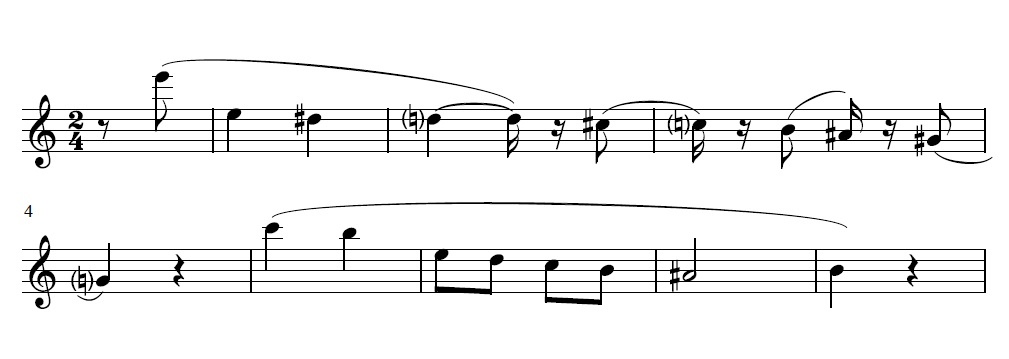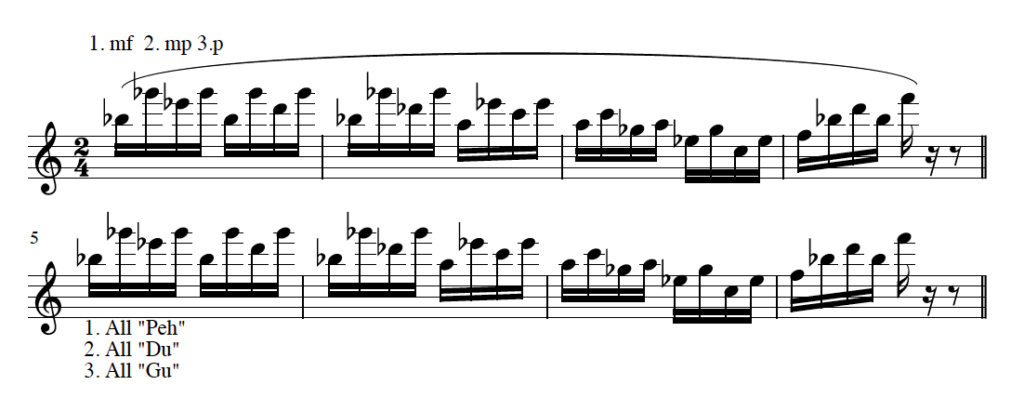My next few blog posts will be tips on some of my favourite pieces from the ABRSM Grade 8 repertoire lists. Even if you aren’t working towards your Grade 8, I hope these tips may provide you with some food for thought when approaching this repertoire.
Poulenc Sonata for Flute and Piano
1st movement: Allegro malincolico
High E
The first challenge of this sonata is the entry on a high E, with some editions marking the entry as piano, however the latest edition is marked mf. Whatever the dynamic, it is good practice to start with a “soft attack”, i.e. a gentle start to the note. This can be achieved with or without the tongue.
A good exercise to practice soft high notes and soft attack is “reverse harmonics”, an exercise that Geoffrey Gilbert and others taught and one that I teach my own students. They work by fingering a high note (e.g. E) and then splitting the note down to its lower partials (“ghost tones”). Once you get to the lowest ghost tone, slowly increase the air speed and lift the airstream by bringing the jaw forwards, but don’t let the dynamic increase. Slow practice with careful attention to not over-using or tightening muscles is important. When you get back to the top note, re-articulate it to practice placing it with the correct air speed and direction. This will give you a greater chance of success! Those of you with a “split E” mechanism on your flutes will have a slightly easier time!

Skeleton
After practicing some soft top Es, have a look at the skeleton of the opening. Notice how the melancholic melody of the first four bars is very chromatic. We want to hear this downward melodic shape when all the notes are added back.

Find where the harmony is stressed and where it releases and show this with your phrasing. For example, the A sharp resolves onto B in bars 7-8. Therefore, phrase towards the A sharp:

There are three repetitions of the main E minor theme, so ideally these should not sound the same. This is perhaps the reasoning for the dynamic markings of p – mf – f in the edition I play from, where each repetition of the theme reinforces the last, like saying something three times: “Tidy your room; tidy your room; TIDY YOUR ROOM!”
With the upward scales, try practising the 7s in different groupings (4+3 and 3+4). It is important to make sure all notes lead to the top note, but equally important that they are together with the piano, which also has a scale. They should provide a moment of excitement after the melancholic melody. They look fast, but you have more time than you might think, so be careful not to rush these.
Coordination
The next challenge is the rapid alternation of E to C, found in bars 26 to 32. Pay attention to the Es and the Cs should take care of themselves. You can practice pitching both E and C by playing them as harmonics of low C, low C and E, and F and A. You’ll find the airspeed and direction of air that you need. Think “ooh” on the E and “aah” on C, encouraging the jaw to swing forwards for the higher note. When you come back to fingering the notes normally, you’ll find it much easier and all the notes will sound with a good tone.

Double tonguing
Whenever students start learning this piece, the double tonguing section (5th bar after Figure 5) often becomes a focus point or stumbling block. It is important to remember that this is an accompaniment to the piano melody, so it needs to be light, following the phrasing of the piano melody. To get a good soft tone on all notes, practice slowly and slurred first, then practice on a “peh” (without the tongue), then each of the tongue strokes “Tu” and “Ku” (or “Du” and “Gu”). Try to keep the vowel that follows the initial consonant the same, i.e. du-gu du-gu du-gu, not de-gu du-ga da-ge, as this will help keep the sound consistent. Practice it a bit louder at first to get comfortable with it, then try it softer.

Then play it as written, paying attention to quality of sound and evenness of tonguing. You can also practice this singing and playing at the same time. If you follow this approach regularly with scales, you’ll find your double tonguing will improve and this section won’t cause you any stress!
At figure 8, we have the “Happy Sarabande” section, where beats 1 and 2 are important. The stress pattern is quite often Stress-Stress-release, much like a Sarabande. The demisemiquavers (32nd notes) need to be cared for and used to help shape the phrases, not thrown away. Make sure all the dynamics come through as these represent the different characters of the same melody.
The last challenge is the final few bars:

Firstly, to be together with the piano requires good rehearsing with your pianist and a clear sense of the rhythm. Subdivide into quavers, so you count the rests carefully. The céder marking can throw some people off. Try not to let this affect your rhythm, but just see it as a moment of coming to rest in terms of dynamic and tempo.
Secondly, the final B, as a perfect 5th above the E and minor 3rd above the G sharp in the piano, can sound flat, so make sure it is pitched high enough for a pleasing chord. Notice how the movement comes to rest on an E major chord, after so much minor tonality. The colour you choose for the final B should reflect this.
I hope these tips help with some of the challenges in this piece, and that they allow more enjoyment of this wonderful music.
Thanks for reading and Happy Fluting!


